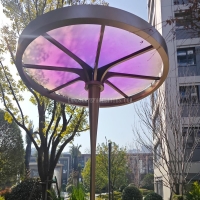Welcome to the website for landscape facilities products and knowledge.
What are the key differences between olefin and acrylic fabrics for landscape sofa upholstery?
When selecting upholstery for landscape sofas, choosing the right fabric is crucial for durability, comfort, and aesthetics. Olefin and acrylic are two popular synthetic fabrics, but they differ significantly in performance and suitability for outdoor use.
1. Composition and Structure
Olefin (polypropylene) is a lightweight, synthetic fabric known for its resistance to moisture, stains, and fading. It has a smooth texture and is often solution-dyed, ensuring long-lasting color. Acrylic, on the other hand, is a synthetic fiber that mimics wool, offering a softer feel and better breathability.
2. Durability and Weather Resistance
Olefin excels in harsh outdoor conditions due to its UV resistance and ability to repel water, making it ideal for rainy climates. Acrylic is also UV-resistant but may absorb moisture, leading to mildew if not properly maintained.
3. Comfort and Aesthetics
Acrylic fabrics are softer and more comfortable against the skin, resembling natural fibers like cotton or wool. Olefin, while durable, can feel less plush and is often chosen for its practicality over comfort.
4. Maintenance
Olefin is low-maintenance, resistant to stains, and easy to clean with water and mild detergent. Acrylic requires more care, as it can attract dirt and may need specialized cleaning to maintain its appearance.
5. Cost and Lifespan
Olefin is generally more affordable and has a longer lifespan in extreme weather. Acrylic, while pricier, offers superior aesthetics but may degrade faster without proper care.
For landscape sofas, olefin is the go-to for durability and low upkeep, while acrylic suits those prioritizing comfort and a premium look. Your choice depends on climate, usage, and personal preference.
Related search:

Recommendation
Metal frame with gradient color acrylic combined with high-end shading landscape facilities